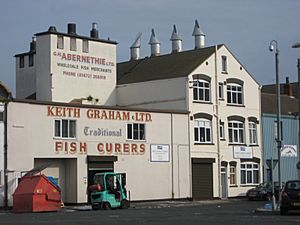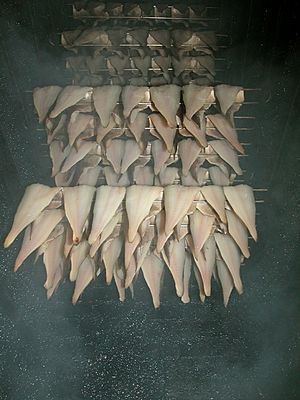Traditional Grimsby smoked fish facts for kids
Traditional Grimsby smoked fish is a special food from Grimsby, England. It's made from fillets of cod and haddock. These fish are smoked using a very old, traditional method. Grimsby was once a huge fishing port. It was the biggest and busiest in the world in the 1950s. This special smoking method gives the fish a unique taste. It's slightly salty and smoky, with a dry texture. The color can be cream to beige.
In 2009, this fish earned a special award. It was given Protected Geographical Indication (PGI) status. This means only fish smoked in Grimsby using the traditional way can use this name.
Contents
The History of Smoked Fish
People have smoked food for a very long time. It was a way to keep fish and meat from going bad. Before fridges and freezers, smoking was super important. It helped people store food for many months.
Today, we have modern ways to keep food fresh. But some foods are still smoked. This is because people love the special taste.
How Smoking Changed Over Time
Before the 1940s, all smoked fish was called "cured." It was made by hanging fish in chimneys. Slowly burning wood shavings created the smoke. Then, new machines called mechanical kilns were invented. These kilns used automatic smoke makers. Some even used liquid smoke!
Traditional smokers then started calling their fish "smoked." This showed their process used real, natural smoke. The older method is now called "traditional smoked." This helps people know the difference.
Grimsby's Fishing Story
Grimsby became one of Europe's biggest fishing ports. This made it a key place for smoking fish. Many old, traditional smokehouses still exist in Grimsby today.
But in the 1970s, things changed. There were conflicts called the Cod Wars. Countries like Iceland and Norway created protected fishing zones. This made it hard for Grimsby fishermen. Also, new rules about fishing limited how much fish could be caught. Many smokehouses closed down. The industry in Grimsby became much smaller.
Luckily, trade with Iceland and Norway started again in the 1980s. Fish began arriving in Grimsby by container. This helped the fish processing industry survive. It also saved the traditional smokehouses.
Making Traditional Grimsby Smoked Fish
Grimsby is a great place for smoking fish. It has cool, dry winds from the North Sea and the Humber estuary. These winds help the fish smoke slowly overnight. The summer temperatures stay cool, which is perfect for cold smoking.
Traditional smoking is a very skilled job. The people who do it learn from their families. This knowledge has been passed down for generations. The special PGI status means producers must follow strict rules. This ensures the fish is made the real, traditional way.
Why Grimsby Fish is Special
Grimsby has one of the busiest fish markets for haddock and cod. This means smokers can buy fresh fish every morning. The fish often comes from Iceland, Norway, and Faroe. Fresh fish is very important for good smoked fish.
Here's how traditional Grimsby smoked fish is made:
- Step 1: Filleting Fresh whole fish are brought in. Skilled workers cut the fish by hand to make fillets.
- Step 2: Brining The fillets are soaked in salty water (brine) for 10 to 15 minutes. Then, they are drained.
- Step 3: Hanging The fish fillets are placed on metal rods called "speats." These speats are hung inside tall smokehouse chimneys.
- Step 4: Smoking Sawdust is placed at the bottom of the smokehouse. A small fire is started to make the sawdust smolder. This creates smoke. The amount of smoke needed depends on the weather. In summer, less fire is needed. In winter, more fire is needed.
- Step 5: Overnight Process The fish stays in the smokehouse overnight for at least 8 hours. Skilled smokers check the fish often. They make sure it smokes evenly. No heat is used, so the fish doesn't cook.
- Step 6: Cooling and Packing After smoking, the fish is removed and cooled. Then, it's packed into special boxes or vacuum-sealed. It's then ready to be sent to shops and restaurants.
Public Interest and Marketing
In 1998, a famous chef named Rick Stein visited Grimsby. He saw the traditional fish smoking process. He was very impressed! He said it was much better than machine-made smoked fish. He even compared it to special French foods with a protected name.
Big supermarkets often prefer machine-smoked fish. This is because machines can make a lot of fish quickly. But traditional smoked fish is becoming very popular. It's a high-quality product. Many top restaurants now want it.
For example, Regal Fish Supplies sells traditional smoked cod and haddock. They get it from Grimsby smokehouses. They sell it all over the UK through their website.
Protecting the Name
In October 2009, Traditional Grimsby Smoked Fish got its special PGI status. This was a big win! It followed a ten-year effort by the Grimsby Traditional Fish Smokers Group. They wanted people to understand the unique skills and traditions behind their fish.
This PGI status means only fish made in Grimsby using the traditional method can use the name. Producers who are part of the Grimsby Traditional Fish Smokers Group are checked regularly. This ensures they follow all the rules. If they do, they can use the PGI logo on their fish. This logo tells customers they are buying the real deal!





